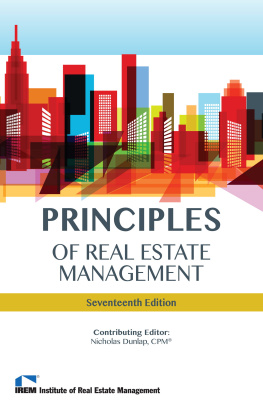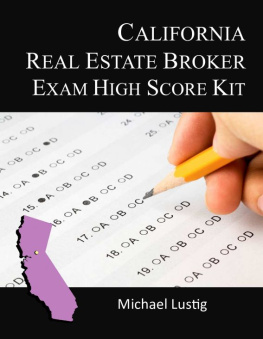Kathryn Haupt - Principles of California Real Estate
Here you can read online Kathryn Haupt - Principles of California Real Estate full text of the book (entire story) in english for free. Download pdf and epub, get meaning, cover and reviews about this ebook. year: 2021, publisher: Rockwell Publishing, genre: Children. Description of the work, (preface) as well as reviews are available. Best literature library LitArk.com created for fans of good reading and offers a wide selection of genres:
Romance novel
Science fiction
Adventure
Detective
Science
History
Home and family
Prose
Art
Politics
Computer
Non-fiction
Religion
Business
Children
Humor
Choose a favorite category and find really read worthwhile books. Enjoy immersion in the world of imagination, feel the emotions of the characters or learn something new for yourself, make an fascinating discovery.

- Book:Principles of California Real Estate
- Author:
- Publisher:Rockwell Publishing
- Genre:
- Year:2021
- Rating:3 / 5
- Favourites:Add to favourites
- Your mark:
- 60
- 1
- 2
- 3
- 4
- 5
Principles of California Real Estate: summary, description and annotation
We offer to read an annotation, description, summary or preface (depends on what the author of the book "Principles of California Real Estate" wrote himself). If you haven't found the necessary information about the book — write in the comments, we will try to find it.
Principles of California Real Estate — read online for free the complete book (whole text) full work
Below is the text of the book, divided by pages. System saving the place of the last page read, allows you to conveniently read the book "Principles of California Real Estate" online for free, without having to search again every time where you left off. Put a bookmark, and you can go to the page where you finished reading at any time.
Font size:
Interval:
Bookmark:

Principles of
California
Real Estate
Kathryn J. Haupt
David L. Rockwell

Copyright 2021
By Rockwell Publishing Company
13218 N.E. 20th
Bellevue, WA 98005
(425)747-7272 / 1-800-221-9347
Nineteenth edition
ALL RIGHTS RESERVED
No part of this book may be reproduced in any form or by any means
without permission in writing from the publisher.
ISBN: 978-1-950728-01-5
PRINTED IN THE UNITED STATES OF AMERICA

- What is Real Property?
- Appurtenances
- Air rights
- Water rights
- Solid mineral rights
- Oil and gas rights
- Other appurtenant rights
- Attachments
- Natural attachments
- Man-made attachments (fixtures)
- Distinguishing fixtures from personal property
- Written agreement
- Method of attachment
- Adaptation to the property
- Intention of the annexor
- Relationship of the parties
- Mobile homes
- Land Description
- Metes and bounds
- Government survey
- Recorded map
- Other methods of land description

Real estate agents are concerned not just with the sale of land and houses, but with the sale of real property generally. Real property includes the land and improvements, and it also encompasses the rights that go along with ownership of land. The first part of this chapter explains those rights, which are known as appurtenances. It also explains natural attachments and fixtures, which are sold as part of the land, and the distinction between fixtures and personal property (which ordinarily is not transferred with the land). The second part of this chapter explains methods of legal descriptionthe different ways in which a parcel of land may be identified in legal documents to prevent confusion about its boundaries or ownership.
What Is Real Property?
There are two types of property: real property (realty) and personal property (personalty). Real property can be defined as land, anything affixed or attached to the land, and anything incidental or appurtenant to the land. Sometimes it is described as that which is immovable. Personal property , by contrast, is usually movable. A car, a sofa, and a hat are simple examples of personal property. Anything that is not real property is personal property.
The distinction between real and personal property is very important in real estate transactions. When a piece of land (a parcel) is sold, anything that is considered part of the real property is transferred to the buyers along with the land, unless otherwise agreed. But if an item is personal property, the sellers can take it with them when they move away, unless otherwise agreed.

Of course, the principal component of real property is land. But this means more than just the surface of the earth. Real property also includes the subsurface : everything beneath the surface of the parcel down to the center of the earth. It also includes the airspace : the space above the surface of the parcel.
A parcel of real property can be imagined as an inverted pyramid, with its tip at the center of the globe and its base above the earths surface. The landowner owns not only the earths surface within the boundaries of the parcel, but also everything under and over the surface.
In addition to the land itself, any improvements to the land are part of the landowners real property. Improvements are things that have been added to, built on, or done to the land to improve or develop it. A house, a driveway, and landscaping are all examples of improvements.
The rights, privileges, and interests associated with land ownership are also considered part of the real property. Think of real property as the land and improvements plus a bundle of rights. The owners bundle of rights includes the right to possess, use, enjoy, encumber, will, sell, or do nothing at all with the land. Of course, these rights arent absolute; theyre subject to government regulation (see Chapter 5).
Appurtenances
In addition to the basic bundle of ownership rights, a landowner has appurtenant rights. An appurtenance is a right or interest that goes along with or pertains to a piece of land. A landowners property may include any or all of these appurtenances:
- air rights,
- water rights,
- solid mineral rights,
- oil and gas rights, and
- support rights.
Appurtenances are ordinarily transferred along with the land, but the landowner can sell certain appurtenant rights separately from the land. For example, the owner may keep the land but sell his mineral rights to a mining company.
Air Rights
Air rights give a landowner the right to use the airspace above her land. In theory, a landowners air rights extend to the upper limits of the sky. In practice, however, this is no longer true. Congress gave the federal government complete control over the nations airspace. Landowners still have the exclusive right to use the lower reaches of airspace over their property, but may do nothing that would interfere with normal air traffic.
On the other hand, sometimes air traffic interferes with a landowners right to the normal use of his land. If aircraft overflights cause substantial harm to a landowner, he may sue the government for some form of reimbursement. The classic example is an airport built right next to a chicken farm. The noise and vibrations from overflights are so severe that the chickens no longer lay eggs. If the land cant be used for any other reasonable purpose, the value of the land is significantly diminished. The landowner may be able to force the government to condemn the property and compensate him for its fair market value. (This is called an inverse condemnation lawsuit; see Chapter 3.)
Water Rights
The right to use water can bebut isnt necessarilyan appurtenant right, tied to land ownership. Because water is vital for agriculture, industry, and day-to-day living, water rights are an important issue in many places, including California.
Water is found both on the surface of the earth and beneath the surface. (The natural level at which water can be located in a particular piece of land is called the water table.) Surface water may be confined to a channel or basin, or it may be unconfined water, such as runoff or flood water. The water beneath the surface may also be confined in the sense that it runs in recognizable underground streams, or it may collect in porous ground layers called aquifers.
In regard to confined surface waters, two systems govern water rights:
- the riparian rights system, and
- the appropriative rights system.
Riparian Rights System. Riparian rights are the water rights of a landowner with respect to water that is adjacent to or flows through her property. For example, someone who owns land beside a stream has the right to make reasonable use of the water for domestic purposes, such as drinking, bathing, and watering a personal-use produce garden. However, upstream riparian owners arent allowed to use the water in ways that could deprive downstream owners of its use; they must not substantially diminish the streams flow in quantity, quality, or velocity.
Font size:
Interval:
Bookmark:
Similar books «Principles of California Real Estate»
Look at similar books to Principles of California Real Estate. We have selected literature similar in name and meaning in the hope of providing readers with more options to find new, interesting, not yet read works.
Discussion, reviews of the book Principles of California Real Estate and just readers' own opinions. Leave your comments, write what you think about the work, its meaning or the main characters. Specify what exactly you liked and what you didn't like, and why you think so.











